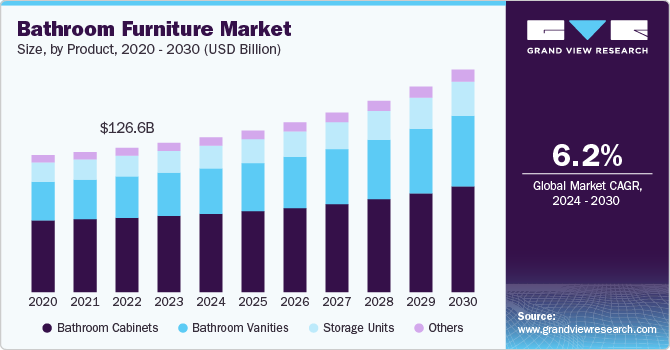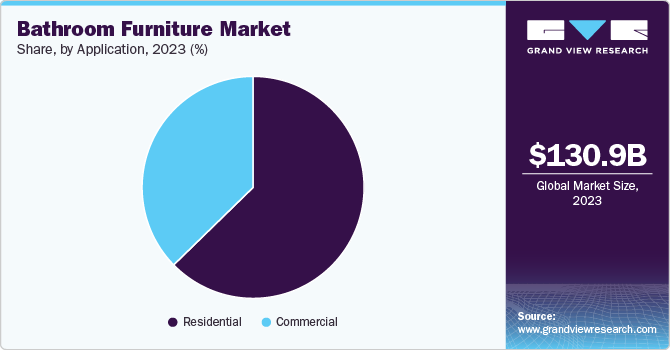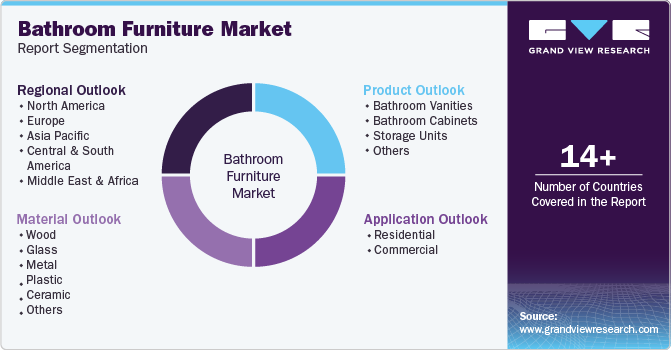- Home
- »
- Homecare & Decor
- »
-
Bathroom Furniture Market Size, Share, Growth Report, 2030GVR Report cover
![Bathroom Furniture Market Size, Share & Trends Report]()
Bathroom Furniture Market Size, Share & Trends Analysis Report By Product (Bathroom Vanities, Bathroom Cabinets, Storage Units), By Material (Wood, Metal, Plastic, Glass, Ceramic), By Application, By Region, And Segment Forecasts, 2024 - 2030
- Report ID: GVR-4-68040-473-4
- Number of Report Pages: 110
- Format: PDF, Horizon Databook
- Historical Range: 2018 - 2023
- Forecast Period: 2024 - 2030
- Industry: Consumer Goods
Bathroom Furniture Market Size & Trends
The global bathroom furniture market size was estimated at USD 130.94 billion in 2023 and is expected to grow at a CAGR of 6.2% from 2024 to 2030. The growth of the market is driven by a combination of factors, including increasing home renovation and remodeling activities as homeowners seek to enhance both functionality and aesthetics in bathrooms. Rising disposable incomes enable consumers to invest in high-quality, stylish furniture that reflects personal tastes. Additionally, the shift towards urban living has created a demand for space-efficient and multifunctional solutions suitable for smaller living spaces further fuel the growth of the market.

The rising trend of home improvement and remodeling projects is significantly influencing homeowners decisions to invest in modern and stylish bathroom furniture, as they seek to create more functional and visually appealing spaces. With many people spending more time at home, there is a heightened focus on enhancing living environments, particularly in often-overlooked areas like bathrooms. Homeowners are increasingly recognizing that well-designed bathroom furniture can not only improve organization and storage but also elevate the overall aesthetic of homes. This shift is driven by the desire for personalized spaces that reflect individual tastes and lifestyles, prompting investments in contemporary vanities, cabinets, and fixtures that incorporate the latest design trends and technological advancements.
Growing awareness of sustainability has become a significant driving force in the bathroom furniture market, as consumers increasingly prioritize eco-friendly materials and practices in purchasing decisions. With heightened concern over environmental issues, such as climate change and resource depletion, many buyers are seeking products that minimize ecological footprint. This has led to a surge in demand for bathroom furniture made from sustainable materials, such as reclaimed wood, bamboo, and recycled composites.
Innovations in design and technology, particularly the integration of smart features and customizable options, are significantly stimulating demand in the bathroom furniture market, as homeowners increasingly seek products that combine convenience with modern aesthetics. The rise of smart home technology has led to the development of bathroom furniture equipped with advanced functionalities, such as touchless faucets, LED lighting with adjustable settings, and built-in charging stations, enhancing the overall user experience. These features provide added convenience and promote energy efficiency and hygiene, appealing to a tech-savvy consumer base.
Product Insights
Bathroom cabinets accounted for a share of around 50% in 2023. As homeowners prioritize organization and decluttering, stylish and functional cabinets have become essential for enhancing bathroom aesthetics while providing practical storage options. The rise in home renovation and remodeling projects also contributes significantly, as consumers look to upgrade bathroom environments with modern designs and materials. Additionally, the growing awareness of sustainability and the use of eco-friendly materials in cabinet production cater to environmentally conscious consumers. Innovations in design, such as customizable and multifunctional cabinets, further fuel the market's growth by offering tailored solutions that meet diverse consumer needs.
The demand for bathroom vanities is expected to grow at CAGR of 7.5% from 2024 to 2030. The desire for personalized and stylish bathroom environments has led to a growing demand for modern vanities that combine design, storage, and efficiency. Additionally, the trend towards smaller living spaces has heightened the need for compact and multifunctional vanities that maximize space without compromising on style. The rise of smart home technology has also influenced the market, with consumers looking for vanities that integrate features such as built-in lighting and charging stations. Furthermore, the growing awareness of sustainability and the use of eco-friendly materials in vanity production resonate with environmentally conscious buyers, further propelling the market forward.
Material Insights
Wooden bathroom furniture accounted for a share of around 30% in 2023. Wood offers a warm, inviting look that can complement various interior styles, from traditional to contemporary, enhancing the overall ambiance of a bathroom. Additionally, advancements in treatment and finishing techniques have improved wood's resistance to moisture and humidity, addressing concerns about longevity in wet environments. The sustainability factor also plays a significant role, as consumers increasingly favor eco-friendly materials; responsibly sourced wood aligns with growing environmental awareness. Furthermore, the ability to customize wooden furniture allows for unique designs that meet specific consumer needs, further solidifying its position in the market.
The demand for ceramic bathroom furniture is expected to grow at CAGR of 8.7% from 2024 to 2030. Ceramic materials are highly resistant to moisture, stains, and scratches, ensuring longevity and reducing the need for frequent replacements. Additionally, the versatility of ceramic allows for a wide range of designs, colors, and finishes, enabling homeowners and designers to achieve various aesthetic looks that cater to personal preferences. The trend toward hygienic and easy-to-clean surfaces also contributes to the popularity of ceramic, as it does not harbor bacteria or mold. Furthermore, advancements in ceramic manufacturing techniques have enhanced the material's aesthetic appeal and functionality, further fueling its demand in the bathroom furniture market.
Application Insights
Bathroom furniture for residential end use accounted for a market share of around 60% in 2023. The demand for bathroom furniture in residential applications is driven by several factors, including the growing trend of home improvement and renovation projects, as homeowners seek to enhance the functionality and aesthetics of bathrooms. Increasing awareness of the importance of organized and efficient storage solutions encourages consumers to invest in furniture that maximizes space and promotes cleanliness. Additionally, the desire for personalized and stylish bathroom environments, combined with a rising focus on sustainability and eco-friendly materials, further propels demand. As more homeowners prioritize comfort and luxury in living spaces, the need for modern, multifunctional bathroom furniture continues to grow.

Commercial application is expected to grow at a CAGR of 7.2% from 2024 to 2030. The growth of bathroom furniture in commercial applications is primarily driven by the increasing focus on enhancing customer experience and satisfaction in sectors such as hospitality, healthcare, and retail. Businesses are investing in high-quality, durable, and aesthetically pleasing bathroom furniture to create a welcoming and functional environment for clients and employees. Compliance with regulations and standards in public restrooms also fuels demand for innovative designs that maximize space efficiency and ensure hygiene. Additionally, the rise of eco-friendly practices and sustainable materials is becoming essential for companies aiming to promote a green image, further contributing to the growth of the bathroom furniture market in commercial settings.
Regional Insights
The bathroom furniture market in North America accounted for a market share of around 32% in 2023 in the global market. The growth of the market in North America is driven by factors such as rising home renovation and remodeling activities, increasing urbanization, and a growing focus on luxury and smart bathroom designs. Consumers are increasingly seeking multifunctional, space-saving, and aesthetically appealing furniture, prompting demand for modern vanities, storage units, and cabinets. The trend toward sustainable living also plays a role, with eco-friendly materials gaining popularity. Additionally, the integration of smart technology in bathroom furniture, such as touchless systems and LED mirrors, further boosts the market as consumers prioritize convenience and innovation in bathroom spaces.
U.S. Bathroom Furniture Market Trends
The bathroom furniture market in the U.S. accounted for a market share of around 78% in 2023 in the North American market. The demand for bathroom furniture in the U.S. is primarily driven by increasing home improvement projects, a shift toward modern and luxurious bathroom designs, and a growing emphasis on functionality and sustainability. Consumers are looking for stylish, space-efficient, and durable furniture that complements interior aesthetics. Leading brands such as Kohler, IKEA, Duravit, Geberit, and American Standard play a significant role in shaping this demand by offering a wide range of products that cater to various tastes, from contemporary to traditional designs, while also incorporating eco-friendly materials and smart technologies.
Europe Bathroom Furniture Market Trends
The bathroom furniture market in Europe accounted for revenue share of around 24% of global revenue in 2023. The demand for bathroom furniture in Europe is driven by growing home renovation trends, increasing focus on sustainability, and a preference for modern, minimalist designs. Countries like Germany, the UK, France, Italy, and Spain are leading the market, with consumers seeking durable, stylish, and eco-friendly furniture solutions. The shift towards smart homes and energy-efficient bathroom fixtures also plays a role in boosting demand, as European consumers prioritize both aesthetics and functionality in bathroom spaces.
Asia Pacific Bathroom Furniture Market Trends
The Asia Pacific bathroom furniture market is expected to grow a CAGR of 8.6% from 2024 to 2030. The growth of the market in Asia Pacific is driven by rapid urbanization, rising disposable incomes, and an increasing focus on home aesthetics. As middle-class populations expand, there is a growing demand for modern, space-efficient, and multifunctional bathroom furniture, particularly in urban areas with smaller living spaces. Additionally, the popularity of home renovation and remodeling projects, along with a growing awareness of sustainable and eco-friendly products, is boosting demand. Emerging markets like China and India, in particular, are experiencing significant growth as consumers seek contemporary designs and high-quality bathroom solutions.
Key Bathroom Furniture Company Insights
The competitive landscape in the market is characterized by the presence of both global and regional players, each competing on design innovation, material quality, and sustainability. Major companies such as Kohler, Geberit, Roca, and Duravit dominate the market with comprehensive product portfolios that cater to various price segments. These brands focus on introducing multifunctional and space-saving furniture, often incorporating smart technology and sustainable materials. Smaller, regional manufacturers also compete by offering customized solutions, niche designs, and competitive pricing. The rise in demand for eco-friendly and modern bathroom furniture further intensifies competition, pushing companies to innovate continuously.
Key Bathroom Furniture Companies:
The following are the leading companies in the bathroom furniture market. These companies collectively hold the largest market share and dictate industry trends.
- Geberit AG
- Roca Sanitario, S.A
- Nilkamal Limited
- Duravit AG
- Laufen Bathrooms AG
- W. Schneider+Co AG
- American Woodmark Corporation
- Design House (DHI Corp.)
- Kohler Company
- Dupont Kitchen and Bath Fixtures
Recent Developments
-
In January 2023, Caesarstone unveiled its latest multi-material surfaces portfolio at the Kitchen & Bath Industry Show, held at the Las Vegas Convention Center in the U.S. The new offerings included Porcelain and Natural Stone ranges, expanding existing Quartz and Outdoor Quartz collections.
-
In October 2022, Geberit expanded its iCon and ONE series with new product enhancements, introducing a range of cabinet and basin solutions. The new Geberit ONE washbasin cabinet and wash tops offer versatile design options, allowing for single or double washbasins paired with either a cabinet, a simple wash top, or a combination of both.
Bathroom Furniture Market Report Scope
Report Attribute
Details
Market size value in 2024
USD 135.94 billion
Revenue forecast in 2030
USD 195.27 billion
Growth rate
CAGR of 6.2% from 2024 to 2030
Actual data
2018 - 2023
Forecast period
2024 - 2030
Quantitative units
Revenue in USD million/billion, and CAGR from 2024 to 2030
Report coverage
Revenue forecast, company ranking, competitive landscape, growth factors, and trends
Segments covered
Product, material, application, region
Regional scope
North America; Europe; Asia Pacific; Central & South America; Middle East & Africa
Country scope
U.S.; Canada; Mexico; UK; Germany; France; Italy; Spain; Japan; China; India; Brazil; Argentina; Saudi Arabia; South Africa
Key companies profiled
Geberit AG; Roca Sanitario, S.A; Nilkamal Limited; Duravit AG; Laufen Bathrooms AG; W. Schneider+Co AG; American Woodmark Corporation; Design House (DHI Corp.); Kohler Company; Dupont Kitchen and Bath Fixtures
Customization
Free report customization (equivalent up to 8 analysts working days) with purchase. Addition or alteration to country, regional & segment scope.
Pricing and purchase options
Avail customized purchase options to meet your exact research needs. Explore purchase options
Global Bathroom Furniture Market Report Segmentation
This report forecasts revenue growth at the global, regional and country levels and provides an analysis of the latest industry trends and opportunities in each of the sub-segments from 2018 to 2030. For the purpose of this study, Grand View Research has segmented the global bathroom furniture market report on the basis of product, material, application, and region.

-
Product Outlook (Revenue, USD Billion, 2018 - 2030)
-
Bathroom Vanities
-
Bathroom Cabinets
-
Storage Units
-
Others
-
-
Material Outlook (Revenue, USD Billion, 2018 - 2030)
-
Wood
-
Glass
-
Metal
-
Plastic
-
Ceramic
-
Others
-
-
Application Outlook (Revenue, USD Billion, 2018 - 2030)
-
Residential
-
Commercial
-
-
Regional Outlook (Revenue, USD Billion, 2018 - 2030)
-
North America
-
U.S.
-
Canada
-
Mexico
-
-
Europe
-
UK
-
Germany
-
France
-
Italy
-
Spain
-
-
Asia Pacific
-
China
-
Japan
-
India
-
-
Central & South America
-
Brazil
-
Argentina
-
-
Middle East & Africa
-
South Africa
-
Saudi Arabia
-
-
Frequently Asked Questions About This Report
b. The global bathroom furniture market was estimated at USD 130.94 billion in 2023 and is expected to reach USD 135.94 billion in 2024.
b. The global bathroom furniture market is expected to grow at a compound annual growth rate of 6.2% from 2024 to 2030 to reach USD 195.27 billion by 2030.
b. North America dominated the bathroom furniture market with a share of around 32% in 2023. The bathroom furniture market in North America is primarily driven by growing home renovation activities, increasing consumer focus on aesthetics and functionality, and the rising demand for eco-friendly and space-saving solutions.
b. Key players in the bathroom furniture market are Geberit AG; Roca Sanitario, S.A; Nilkamal Limited; Duravit AG; Laufen Bathrooms AG; W. Schneider+Co AG; American Woodmark Corporation; Design House (DHI Corp.); Kohler Company; and Dupont Kitchen and Bath Fixtures.
b. Key factors driving the bathroom furniture market include increasing demand for stylish and space-efficient designs, growing home renovation trends, rising consumer interest in eco-friendly materials, and advancements in smart bathroom technology.
Share this report with your colleague or friend.
![gvr icn]()
NEED A CUSTOM REPORT?
We can customize every report - free of charge - including purchasing stand-alone sections or country-level reports, as well as offer affordable discounts for start-ups & universities. Contact us now
![Certified Icon]()
We are GDPR and CCPA compliant! Your transaction & personal information is safe and secure. For more details, please read our privacy policy.
We are committed towards customer satisfaction, and quality service.
"The quality of research they have done for us has been excellent."





